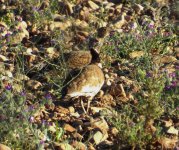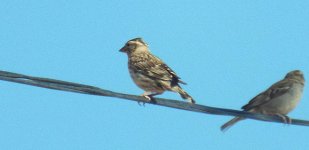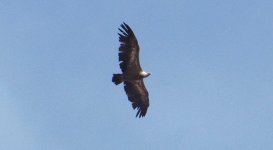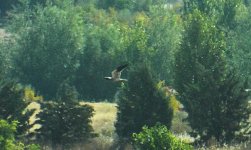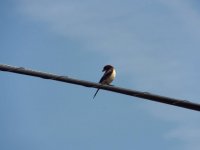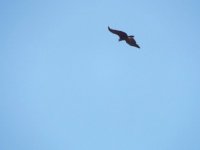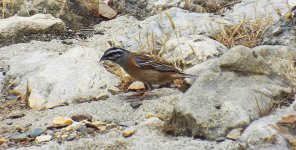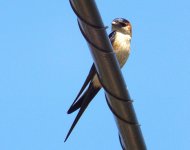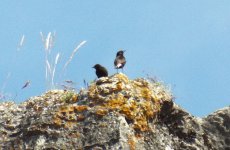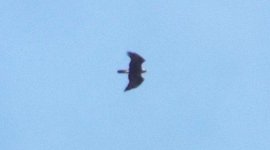Alexjh1
Well-known member
At fairly short notice, my girlfriend and I decided to book a short break in Madrid, which while not for birding primarily, I would get out to do a bit of bird-watching in this ecologically rich area. Due to the limited time we would be there and the limited public transport options to a lot of the habitats I decided to do something I hadn't done before, and book a guide for a half day - I went with Luis Sitges for the morning for the cost of 75 euros, which for the number of lifers proved to be great value.
Quick key for skim reading:
BIRDS PREVIOUSLY SEEN
NEW LIFE BIRD
NEW SUB-SPECIES/POSSIBLE FUTURE SPLIT
DAY 0 - Arrival
We got a morning flight to Luton and arrived into Madrid at about 10am local time, a small number of birds were seen during landing from the window including SPOTLESS STARLING and HOUSE SPARROW. We were however well in advance of our check in time, so decides to do a bit of exploring. The temperature was 33 degrees, and about 40% humidity so a bit uncomfortable, but we explored the markets and shops around Sol and Plaza Mayor and quickly became aquainted with by far the most numerous bird of the trip - COMMON SWIFT - we saw thousands over the course of the visit and they were spectacularly abundant in most areas of human habitation. There may have been pallid swift in there but as I've never seen that species I couldn't pick them out. Plaza Mayor also had a population of HOUSE MARTIN which weren't so common elsewhere on the trip.
We passed to our hotel through El Retiro Park where we saw a few other species including GOLDFINCH, EURASIAN MAGPIE and GREAT TIT and as our hotel was near the edge of the park, we visited again later in the evening and walked up to the large lake area where EURASIAN COOT and MALLARD were added to the proceedings.
Day 1.
Luis picked us up from our hotel at 7.30 and drove through traffic to the sites he'd planned out in response to my request for Steppe species. My first sighting from the van was a probable female MARSH HARRIER, but the real sightings began when he drove down the first side road to look for species and Luis immediately picked out a small group of LITTLE BUSTARD at short range - a species which I had considered a fairly outside chance for the trip and Luis confirmed was difficult to see in Summer. A great start!
Luis then drove us down some farm tracks to look for other species - we first picked up RED-LEGGED PARTRIDGE, followed by CRESTED LARK but nothing particularly spectacular was showing at any visible range, so Luis turned the van around and we continued down another track. However, as we drove past a small olive grove farmhouse a HOOPOE flew out and landed on a branch right in front of us giving great views for a couple of minutes before flying off. We then drove on a little further and stopped in the drive to the farmhouse to scan the surrounding fields - a walker on the far side of the field flushed a GREAT BUSTARD and a BEE-EATER flew over, while Luis spotted another Little Bustard and a COMMON BUZZARD.
We pulled up a little further up the track, and only seeing the standard birds of Spain, turned round and went down another side track. This proved much more productive as I caught a glimpse of two birds in flight which turned out to be a pair of STONE CURLEW as well as a distant glimpse of a grey male harrier that vanished before it could be identified and some big raptor far too distant to get a clear ID on with a supporting cast of an Iberian Hare crossing the tracks behind us.
To be continued...
Quick key for skim reading:
BIRDS PREVIOUSLY SEEN
NEW LIFE BIRD
NEW SUB-SPECIES/POSSIBLE FUTURE SPLIT
DAY 0 - Arrival
We got a morning flight to Luton and arrived into Madrid at about 10am local time, a small number of birds were seen during landing from the window including SPOTLESS STARLING and HOUSE SPARROW. We were however well in advance of our check in time, so decides to do a bit of exploring. The temperature was 33 degrees, and about 40% humidity so a bit uncomfortable, but we explored the markets and shops around Sol and Plaza Mayor and quickly became aquainted with by far the most numerous bird of the trip - COMMON SWIFT - we saw thousands over the course of the visit and they were spectacularly abundant in most areas of human habitation. There may have been pallid swift in there but as I've never seen that species I couldn't pick them out. Plaza Mayor also had a population of HOUSE MARTIN which weren't so common elsewhere on the trip.
We passed to our hotel through El Retiro Park where we saw a few other species including GOLDFINCH, EURASIAN MAGPIE and GREAT TIT and as our hotel was near the edge of the park, we visited again later in the evening and walked up to the large lake area where EURASIAN COOT and MALLARD were added to the proceedings.
Day 1.
Luis picked us up from our hotel at 7.30 and drove through traffic to the sites he'd planned out in response to my request for Steppe species. My first sighting from the van was a probable female MARSH HARRIER, but the real sightings began when he drove down the first side road to look for species and Luis immediately picked out a small group of LITTLE BUSTARD at short range - a species which I had considered a fairly outside chance for the trip and Luis confirmed was difficult to see in Summer. A great start!
Luis then drove us down some farm tracks to look for other species - we first picked up RED-LEGGED PARTRIDGE, followed by CRESTED LARK but nothing particularly spectacular was showing at any visible range, so Luis turned the van around and we continued down another track. However, as we drove past a small olive grove farmhouse a HOOPOE flew out and landed on a branch right in front of us giving great views for a couple of minutes before flying off. We then drove on a little further and stopped in the drive to the farmhouse to scan the surrounding fields - a walker on the far side of the field flushed a GREAT BUSTARD and a BEE-EATER flew over, while Luis spotted another Little Bustard and a COMMON BUZZARD.
We pulled up a little further up the track, and only seeing the standard birds of Spain, turned round and went down another side track. This proved much more productive as I caught a glimpse of two birds in flight which turned out to be a pair of STONE CURLEW as well as a distant glimpse of a grey male harrier that vanished before it could be identified and some big raptor far too distant to get a clear ID on with a supporting cast of an Iberian Hare crossing the tracks behind us.
To be continued...




